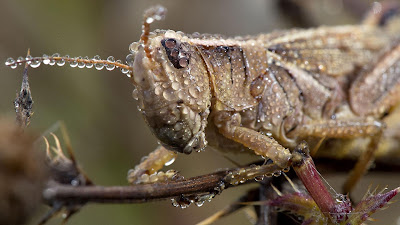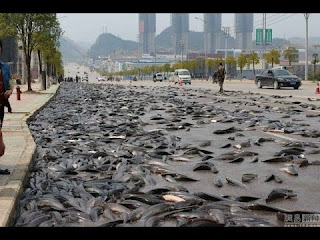The
Weirdest Weather Events of 2018 So Far
By Jon
Erdman
June
28 2018 01:45 PM EDT
weather.com
We've already seen our share of
winter storms, severe weather, cold outbreaks, flooding and droughts so far in
2018. But there are some weather events every year that are downright strange,
and this year is no exception.
The events we consider strange are weather
phenomena happening repeatedly in one place, in a place where you wouldn't
think they would occur or during an unusual time of year. Some are
phenomena you may not find in a Weather 101 textbook.
Here are some of weirdest weather
events we've seen so far in 2018, in chronological order.
Freezing Rain in Florida
Just after New Year's Day, Winter
Storm Grayson blanketed Tallahassee, Florida, with its first measurable
snow since 1989, and the first January such occurrence, there, in records
dating to 1885. That's eye-catching enough. What was even
more bizarre was seeing an ice accumulation map involving the Sunshine
State. Up to a quarter inch of ice accumulation was measured in Lake City, and
light icing on elevated surfaces was reported as far south as Levy
County.
February 80s in New England
The heat in New England
Feb. 20-21 was the "most extraordinary heat event to
ever affect the Northeastern quadrant of the U.S. during the month of February,
since official records began in the late 1800s," according to Weather
Underground weather historian Christopher Burt. All-time state
February heat records were tied or broken in eight states, including 77 degrees
at Wells, Maine, 80 degrees at Fitchburg, Massachusetts, 83 degrees at
Harrisburg, Pennsylvania, and 80 degrees at Cincinnati's Lunken Airport.
The Four-easters
Perhaps as payback for the
summerlike February heat wave, four nor'easters –
Winter Storms Riley, Quinn, Skylar and Toby – in three
weeks brought misery to millions along the Eastern Seaboard in March
2018. Incredibly, a fifth low-pressure center was
a bit too far offshore near the end of March to join the fearsome foursome from
earlier in the month.
A Horseshoe Cloud
While the nor'easter parade was
hammering the East Coast, a bizarre cloud was captured in video over Nevada in
early March. As meteorologist Jonathan Belles explained, this rare
horseshoe vortex is fleeting, lasting only minutes, when a relatively flat
cloud moves over a column of rising air, which also gives the cloud some spin.
A State Record Hailstone
Alabama's notorious history of
severe weather, particularly tornadoes,
is well documented. On March 19, however, it was a hailstone that
captured meteorologists' attention. One softball-size hailstone near
Cullman, Alabama, was found to set a new state record, more than 5 inches in
diameter.
Orange Snow
Just after spring officially arrived
in late March, a plume of dust tapped by southerly winds from north Africa,
lead to the sight of orange snow over parts of eastern Europe. While not
unheard of, this particular orange snow event observed in parts of Russia,
Bulgaria, Ukraine, Romania and Moldova featured higher concentrations of dust than usual,
according to the BBC.
New U.S. Rainfall Record?
Less than eight months after Hurricane Harvey smashed
a rainfall record for any U.S. tropical cyclone, a deluge in Hawaii
appeared to have set another U.S. rain record. A location on the
island of Kauai measured 49.69 inches of rain in just 24 hours from April
14-15. If that is verified, it would top the U.S. 24-hour rain record of 43
inches in Alvin, Texas, during Tropical Storm Claudette in July 1979.
Apriluary, Then a Record Warm May
The coldest April in 21 years for
the Lower 48 states was followed by the hottest May, in NOAA records
dating to 1895. Climate scientist Dr. Brian Brettschneider wrote
this was the largest area of Earth to undergo a record cold-to-warm shift in
consecutive months in the last 100 years. Minneapolis-St. Paul went from
its heaviest April snowstorm of record in
mid-April to a Memorial Day high of 100 degrees in just six weeks.
New England Long-Track Tornado in May
A 36-mile long EF1 tornado May
4 in western and central New Hampshire was one of the longest on record in New
England. As strange as an early-May tornado of any kind is in New
Hampshire – its typical peak tornado month is July – perhaps the
most amazing aspect to this was how the tornado was discovered. The
National Weather Service office in Gray, Maine, gathered public storm reports,
then surveyed relatively remote parts of New Hampshire 10 days after the
tornado to piece together its path.
Subtropical Cyclone Off Chile
The northeastern Pacific basin's
hurricane season starts in mid-May. In early May 2018, however, a bizarre
subtropical cyclone formed in the southeast Pacific Ocean, off the coast of
Chile. This appeared to have been a first-of-its-kind storm to
form over this typically colder stretch of the southeast Pacific Ocean,
according to long-term records.
Wildfire Spawns a Severe
Thunderstorm
Lightning from thunderstorms can
often trigger wildfires. On May 11, however, heat generated from the Mallard Fire
southeast of Amarillo, Texas, generated not just a photogenic pyrocumulus cloud, but also
triggered a severe thunderstorm that ended up dumping quarter-size hail in
Wheeler County, Texas, just over 60 miles away.
Back-to-Back Middle East Tropical Cyclones in Unusual Locations
In less than a week in May, a pair
of tropical cyclones took unusual tracks in the Middle East. First,
Tropical Cyclone Sagar tracked almost the entire length of the Gulf of Aden
before landfalling in far western Somalia on May 19, the country's strongest and
westernmost in records since the mid-1960s. Six
days later, Tropical Cyclone Mekunu moved ashore near Salalah, Oman, the
first Category 3 landfall
in southwest Oman in modern records, dumping over 24 inches of rain in four days
in the city.
Alberto is Pure Michigan
After a Memorial Day landfall in the
Florida Panhandle, deep moist air and the lack of strong shearing winds kept
what was once Subropical Storm Alberto's remnant circulation intact
well inland, to the degree that NOAA's Weather Prediction Center didn't issue
its final advisory until Alberto was just southwest of Alpena, Michigan, on May
31. The only other tropical cyclone to have tracked within 75 miles of
Alpena since the mid-20th century, according to NOAA, was
Connie, as a tropical storm in August 1955. As The Weather Channel senior
meteorologist Stu Ostro pointed out, this was also a highly unusual track for May.
Two Wyoming EF3 Tornadoes in Less
Than a Week
In the first six days of June, a
pair of EF3 tornadoes tore
through areas near Gillette and Laramie, Wyoming, the first F/EF3 or
stronger tornadoes in the state since 1987. Wyoming's low population
density typically minimizes the chance of a tornado hitting structures or
even trees to allow the National Weather Service to rate a tornado. The June 6
tornado north of Laramie scoured grass from the ground, allowing the
NWS to rate it EF3.
Snow After Summer Arrives
Imagine shoveling snow five days
after the summer solstice. This happened on June 26, when a storm off
the coast of Newfoundland had just enough cold air to blanket parts of the
island with snow, prompting plows to be called out. It was one of the
latest-in-season snowfalls on record in Gander. Kids had to to trudge through
snow during their last week of school before summer vacation.



























































